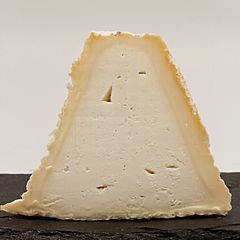Pouligny-Saint-Pierre cheese facts for kids
Quick facts for kids Pouligny-Saint-Pierre |
|
|---|---|
 Pouligny-Saint-Pierre Pouligny-Saint-Pierre Texture of Pouligny-Saint-Pierre |
|
| Country of origin | France |
| Region, town | Berry |
| Source of milk | Goats |
| Pasteurised | No |
| Texture | Soft cheese with natural mould rind |
| Aging time | 2-5 weeks |
| Certification | French AOC 1976 |
| Named after | Lua error in Module:Wikidata at line 70: attempt to index field 'wikibase' (a nil value). |
Pouligny-Saint-Pierre is a special kind of cheese from France. It is made from the milk of goats. This cheese comes from the Indre area in central France. Its name comes from the town of Pouligny-Saint-Pierre, where it was first made a long time ago in the 1700s.
This cheese is easy to spot because of its unique shape. It looks like a small pyramid! It is golden brown and has tiny spots of grey-blue mould on it. People sometimes call it the "Eiffel Tower" or "Pyramid" cheese because of its shape.
A Pouligny-Saint-Pierre cheese has a square bottom that is about 6.5 centimeters (2.5 inches) wide. It stands about 9 centimeters (3.5 inches) tall. Each cheese weighs around 250 grams (about 9 ounces). The inside of the cheese is bright white and feels smooth but crumbly. It tastes a bit sour at first, then salty and sweet. The outside of the cheese has a smell that reminds some people of hay.
This cheese is only made from milk that has not been pasteurized. This means the milk has not been heated to kill germs. There are two main ways it is made: by farmers (called fermier) or by larger dairies (called industriel). The cheese made by farmers has a green label, and the cheese from dairies has a red label. This cheese is only made in a small area, covering just 22 towns.
How Pouligny-Saint-Pierre Cheese is Made
Making this cheese is similar to how many other famous goat cheeses from the Loire Valley are made. First, the goat milk is left to thicken. Then, the thick milk is poured into special moulds that have holes. These holes help the extra liquid, called whey, drain away.
After draining, the cheese is moved to a well-ventilated cellar. Here, it dries and ages for at least two weeks. The best cheeses are left to age for up to five weeks. Today, this cheese is made all year round. However, farmers usually make it only from spring to autumn.
Pouligny-Saint-Pierre cheese received a special status called AOC in 1976. This means its quality and origin are protected by French law. In 2005, about 294 tons of this cheese were made. More than half of it (55%) was made by farmers.
See also
 In Spanish: Pouligny Saint Pierre (queso) para niños
In Spanish: Pouligny Saint Pierre (queso) para niños

